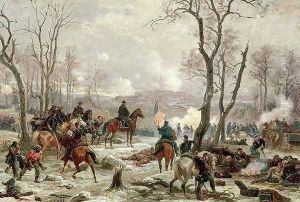Paul Phillipoteaux Paintings
Paul Dominique Philippoteaux, often known as Paul Philippoteaux, was a French artist who gained fame for his large-scale panoramic paintings and his work in the development of cycloramas, which are massive 360° paintings designed to be viewed from the inside, providing a panoramic view of a historical scene or landscape. Born on January 27, 1846, in Paris, France, he was the son of artist Henri Emmanuel Philippoteaux, who was also known for his panoramic paintings and who undoubtedly influenced his son's career path.
Philippoteaux specialized in historical scenes and is most famous for his depiction of the Battle of Gettysburg in the form of a cyclorama, which was commissioned by a group of Chicago investors in the late 19th century. To ensure accuracy, he conducted extensive research, including interviews with veterans of the battle, onsite visits to Gettysburg, and examination of photographs and sketches. His dedication to detail and his ability to convey the drama of historical events made his work particularly valued.
The Gettysburg Cyclorama became a significant cultural attraction and is considered one of Philippoteaux's masterpieces. It was completed in 1883 and originally displayed in Chicago before versions were also shown in Boston, Philadelphia, and other cities. The cyclorama was an immersive experience for viewers, who stood in the center of the circular painting, which was accompanied by a detailed foreground of terrain and props to enhance the three-dimensional effect.
Throughout his career, Philippoteaux was also involved in the creation of other panoramas and worked on various historical and battle scenes. His work was part of the larger trend of panoramic painting in the 19th century, which was a popular form of entertainment before the advent of cinema.
Paul Philippoteaux died on June 28, 1923, in Paris, leaving behind a legacy as one of the key figures in the art of the panorama. His work, especially the Gettysburg Cyclorama, remains an important reference for both art historians and historians of the American Civil War, illustrating how art can serve as a powerful tool in recording and commemorating historical events.
